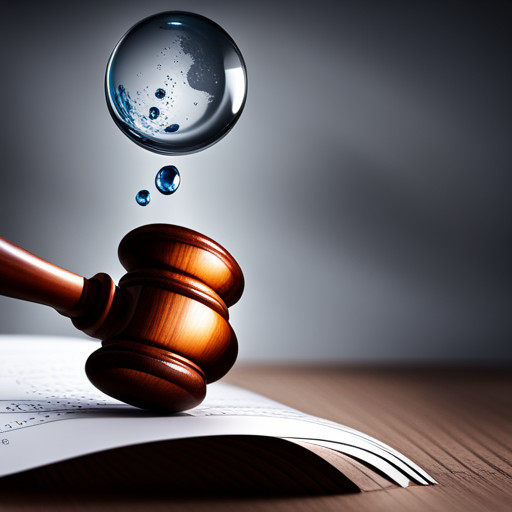Getting the Justice You Deserve: A Guide to Toxic Water Claims
This article explores the complexities of toxic water claims. It highlights the importance of identifying contaminated water sources, understanding common types of contaminants, and outlining health implications.

It further delves into the legal aspects of toxic water claims. It discusses interactions with insurance companies and possible compensations.
The article also examines the appeals process for toxic water claims. It provides key takeaways from successful cases, serving as a comprehensive guide to navigate through toxic water claims.
Overall, this article aims to provide a thorough understanding of toxic water claims and the various factors involved in pursuing and resolving such claims.
Key Takeaways
- Understand the fundamental aspects of toxic water claims and the identification of toxic substances in the water supply.
- Recognize the extensive health risks associated with contaminated water, including diseases, neurological disorders, and hormonal imbalances.
- Implement measures to prevent water contamination, such as conducting scientific tests, raising public awareness, and promoting responsible water use.
- File a toxic water claim by proving negligence, establishing a direct link between contamination and health problems, and gathering extensive evidence and expert testimonies.
Understanding the Basics of Toxic Water Claims

To initiate a discourse on the topic, it is essential to comprehend the fundamental aspects of toxic water claims. This involves understanding the nature of the contaminants involved, the health risks they pose, and the legal recourse available to affected individuals.
The process begins with the identification of the toxic substances present in the water supply. These can range from heavy metals like lead and arsenic to volatile organic compounds (VOCs) and harmful bacteria. Furthermore, the toxicity levels of these contaminants are crucial in determining the severity of the claim, as higher concentrations often lead to more severe health effects.
The health risks associated with contaminated water are extensive and can manifest in various forms. Immediate effects may include skin rashes, gastrointestinal disorders, and respiratory problems, while long-term exposure can lead to chronic diseases like cancer, liver damage, and neurological disorders. Thus, establishing a clear link between the contamination and the health issues is a fundamental claim prerequisite.
In terms of legal recourse, affected individuals can file a toxic water claim to seek compensation for medical expenses, pain and suffering, loss of earnings, and in some cases, punitive damages. However, claim prerequisites include proving negligence or wrongful act on the part of the entity responsible for the water contamination, and demonstrating a direct link between the contamination and the health problems incurred. These prerequisites necessitate extensive evidence gathering, expert testimonies, and in-depth legal knowledge, highlighting the complexity of toxic water claims.
The Importance of Identifying Contaminated Water Sources

Identifying contaminated water sources holds paramount importance in the prevention of health risks and safeguarding the environment. This identification process involves a series of scientific tests and assessments to determine the presence of harmful substances. The significance of such a process cannot be overstated as it forms the basis of contamination prevention methods, which are crucial in maintaining the health of ecosystems and human populations.
The development and implementation of public awareness strategies play a significant role in the overall process of identifying and preventing water contamination. Such strategies involve disseminating information regarding the dangers of contaminated water, the importance of clean water, and the steps individuals can take to prevent pollution. These public awareness strategies can include community education programs, public service announcements, and the promotion of responsible water use.
In addition to public awareness, contamination prevention methods are equally significant. These methods may involve strict regulations on industrial waste disposal, the promotion of sustainable farming practices to prevent runoff, and the provision of adequate sanitation facilities. It is also essential to continually monitor water sources for signs of contamination, which involves the use of advanced scientific equipment and methodologies.
Common Types of Contaminants Found in Water

Common contaminants found in water sources range from biological substances such as bacteria, viruses, and parasites to chemical substances, including heavy metals, pesticides, and pharmaceutical residues. These contaminants, if left untreated by adequate water filtration methods, can lead to serious health effects.
Biological contaminants, such as bacteria, viruses, and parasites, pose substantial health risks. Diseases such as cholera, typhoid, and dysentery are commonly linked to these contaminants. Chemical substances such as heavy metals, pesticides, and pharmaceutical residues can lead to various health issues, including neurological disorders, cancers, and hormonal imbalances.
| Contaminant Type | Health Effects |
|---|---|
| Biological (Bacteria, Viruses, Parasites) | Cholera, Typhoid, Dysentery |
| Heavy Metals | Neurological Disorders |
| Pesticides | Hormonal Imbalances |
| Pharmaceutical Residues | Antibiotic Resistance |
| Industrial Chemicals | Cancers |
Effective water filtration methods are vital in mitigating these risks. These methods range from simple, physical techniques such as sedimentation and filtration to more complex processes like reverse osmosis and UV treatment. The choice of method depends on the nature and extent of contamination.
However, these methods are not foolproof and may not fully eliminate certain contaminants, especially at low concentrations. Continuous research and innovation in water filtration technology are, therefore, essential to ensure the provision of safe and clean water for all.
Health Implications of Drinking Toxic Water

Health implications arising from the consumption of contaminated water have been extensively documented, highlighting the importance of ensuring clean, safe water supplies for all. Exposure to such water can lead to severe health challenges, including gastrointestinal illness, reproductive problems, and neurological disorders, among others.
Prevention Measures are crucial in averting the detrimental health effects of polluted water. These include regular testing of water supplies, usage of appropriate treatment methods, and proper handling and storage of clean water. The implementation of stringent regulations and standards for water quality can play a pivotal role in preventing the contamination of water sources. Additionally, raising awareness about the potential hazards of consuming unsafe water is essential.
In situations where exposure to contaminated water has already occurred, Health Recovery becomes paramount. This often involves the treatment of symptoms and underlying conditions caused by the contaminants, which could range from acute illnesses such as cholera and typhoid to chronic conditions like cancer and liver disease.
There is a pressing need for comprehensive strategies that combine both prevention measures and health recovery approaches to tackle the issue of water contamination effectively. This not only involves the medical and public health sectors but also requires active participation from environmental and legal entities. The collaborative efforts of these sectors can help ensure the right to clean, safe water for all members of society, thereby reducing the health implications associated with the consumption of toxic water.
Legal Aspects of Filing a Toxic Water Claim

Legal recourse is often available to individuals who have suffered health implications as a result of exposure to contaminated water, with the filing of a lawsuit being a potential method of seeking compensation for damages incurred. The process requires a thorough understanding of claimant rights and potential legal defenses that may be used by the party responsible for the contamination.
* Claimant Rights
Under the law, victims of toxic water exposure have the right to seek compensation for any health-related damages they sustain. This includes medical expenses, lost wages due to illness, and in some cases, damages for pain and suffering. Claimants also have the right to legal representation in their pursuit of justice. This includes access to the legal process, the ability to present evidence, and the chance to challenge any defenses put forth by the opposing party.
* Legal Defenses
On the other hand, the party responsible for the contamination may employ various legal defenses. One common defense is to challenge the cause of the claimant's health issues, arguing they are not a result of the contaminated water. Another defense often used is a statutory limitation, arguing that the claimant did not file the lawsuit within the legally allowable timeframe.
Gathering Evidence for Your Claim

Gathering substantial evidence is a critical step in substantiating any compensation claim related to contaminated water exposure. This process involves a meticulous combination of Evidence Preservation Strategies and Digital Documentation Techniques.
Evidence preservation begins immediately after the identification of the contamination source. This may involve collecting water samples, photographing the area, or securing important documents. It is essential to ensure that these pieces of evidence are preserved in their original state to maintain credibility.
On the other hand, Digital Documentation Techniques offer an efficient and reliable way to capture and store evidence. This can involve digital photography, video recording, electronic data collection, and online data storage. These techniques ensure that evidence is accessible and can be easily presented when needed.
The following table presents a summary of various strategies and techniques used in gathering and preserving evidence for a contaminated water claim:
| Evidence Preservation Strategies | Digital Documentation Techniques |
| Water sample collection | Digital photography |
| Photographic documentation | Video recording |
| Secure document storage | Electronic data collection |
| Witness statements | Online data storage |
| Legal document preservation | Digital data backup |
Role of Expert Witnesses in Toxic Water Cases

In toxic contamination lawsuits, the incorporation of expert witnesses plays a critical role in reinforcing the credibility of collected evidence and enhancing the overall strength of the claim. These professionals bring specialized knowledge and experience to the table, which, when articulated in a lucid and persuasive manner, can significantly influence the outcome of the case. The process, however, requires careful selection and meticulous testimony preparation.
The role of expert witnesses can be broadly classified into two categories, each with unique responsibilities:
* Scientific Experts: These are typically individuals with extensive knowledge in the field of environmental science, toxicology, or public health. They are responsible for:
* Verifying the scientific validity of the evidence presented.
* Explaining complex scientific concepts in a simple, comprehensible language to the jury.
* Establishing a clear cause-and-effect relationship between the toxic contamination and the health issues suffered by the plaintiff.
* Legal Experts: These are seasoned attorneys or legal scholars with a deep understanding of environmental laws and regulations. Their primary responsibilities include:
* Evaluating the legal aspects of the case.
* Providing insight into the interpretation and application of relevant laws.
* Supporting the legal strategy by validating the arguments made.
Regardless of their field of expertise, all expert witnesses must possess impeccable witness credibility. This is often determined by their qualifications, professional achievements, and ability to deliver clear, unbiased, and persuasive testimonies. Thorough testimony preparation also plays a key role in this aspect, as it helps the witnesses anticipate potential cross-examination questions and respond to them effectively.
Determining Liability in Toxic Water Claims

In the realm of toxic water claims, two critical aspects warrant meticulous examination: the identification of responsible parties and the comprehension of applicable liability laws.
The identification of responsible parties involves the often complex process of delineating the entities or individuals whose actions or neglect have directly led to the contamination event.
Meanwhile, the comprehension of applicable liability laws necessitates an in-depth understanding of laws and legal precedents, which govern the attribution of liability in such cases. This understanding provides a framework for determining culpability and potential damages.
Identifying Responsible Parties
Determining the parties responsible for toxic water contamination often involves a comprehensive investigation into potential sources such as industrial facilities, municipal water systems, or agricultural runoff. Key to this process is understanding regulatory oversights and corporate accountability.
Regulatory oversights may involve:
- Failure of government agencies to enforce environmental laws
- Inadequate inspection of industrial facilities
- Negligent permitting of hazardous waste disposal
Corporate accountability encompasses:
- Companies failing to adhere to environmental standards
- Improper waste disposal methods
- Negligence in maintaining infrastructure to prevent leaks
Identifying responsible parties requires thorough analysis of these aspects. This objective, fact-based approach ensures a comprehensive understanding of potential liability, critical for those seeking justice for toxic water claims.
Understanding Liability Laws
Understanding liability laws is crucial in cases of environmental contamination, as these regulations define the legal responsibilities of parties involved in the release of harmful substances into water sources. Legislative influences and environmental regulations often intersect to shape these liability laws.
| Liability Law | Legislative Influence | Effect on Environmental Regulations |
| Clean Water Act | Congress amended law in 1972 | Controls water pollution |
| Resource Conservation and Recovery Act | Enacted in 1976 | Manages hazardous waste |
| Comprehensive Environmental Response, Compensation, and Liability Act | Enacted in 1980 | Handles hazardous waste site cleanup |
| Emergency Planning and Community Right-to-Know Act | Enacted in 1986 | Helps communities plan for emergencies |
| Oil Pollution Act | Enacted in 1990 | Deals with oil spill liability |
These laws form a comprehensive framework that can guide parties seeking justice in environmental contamination cases.
The Process of Filing a Lawsuit for Contaminated Water

In the pursuit of justice regarding contaminated water incidents, several pivotal steps necessitate thorough examination.
Firstly, the identification of the contamination source is crucial. This step involves investigating and determining where the contamination originated from, whether it be a specific company, facility, or other source.
Secondly, the selection of legal representation is a crucial determinant in the trajectory of the lawsuit. The choice of an attorney or law firm significantly influences the strategic roadmap, negotiation tactics, and ultimately, the outcome of the case. It is important to find a lawyer with experience in environmental law and a track record of success in similar cases.
Additionally, an understanding of the anticipated timeline for such lawsuits is essential. These litigation processes can be protracted, with various stages from filing to resolution requiring intricate planning and preparation. It is important to be aware of the potential length of the legal battle and to have realistic expectations about the time it may take to achieve a resolution.
Identifying Contamination Source
Establishing the source of water contamination forms the essential first step in any toxic water claims process. It is crucial to understand that contamination can occur due to a myriad of reasons. Many times, these are linked to contamination prevention strategies that failed or regulatory oversight failures.
Contamination prevention strategies are designed to safeguard water sources, but their effectiveness is often compromised due to:
- Poor implementation
- Lack of regular monitoring and maintenance
Regulatory oversight failures can be attributed to:
- Insufficient regulations
- Lax enforcement of existing laws
- Corruption or negligence
Legal Representation Choices
Choosing appropriate legal representation is a critical decision that could significantly impact the outcome of contamination-related lawsuits. Successful legal system navigation requires comprehensive understanding of environmental laws, regulations, and case precedents. Attorneys specializing in environmental law and toxic torts possess the knowledge and experience to effectively advocate for victims of contaminated water. They can assess the viability of a lawsuit, gather pertinent evidence, and argue convincingly in court.
Class action suits, in particular, offer benefits such as shared legal costs and collective bargaining power. However, individual circumstances and specific aspects of each case must be considered. Therefore, comprehensive evaluation of various legal representation options is instrumental in securing justice for those affected by water contamination.
Lawsuit Timeline Expectations
Understanding the timeline for a lawsuit is crucial, as legal processes involving contamination-related cases can be complex and lengthy. The process begins with Case Preparations, where evidence is collected, and liability is established. It's during this stage that the extent of damages is identified.
Settlement Negotiations then follow, where parties attempt to reach an agreement to avoid a trial. This includes discussions about the damages and an agreement on a resolution.
This sequence is generally followed in contamination-related cases. However, if Settlement Negotiations fail, the case proceeds to trial.
These stages reflect a general timeline and can vary based on the case's complexity. Knowledge of this process is beneficial for those seeking justice in toxic water claims.
Dealing With Insurance Companies in Toxic Water Claims

Navigating the complexities of insurance policies and claims processes is a critical component in pursuing toxic water claims. Effective insurance negotiation strategies can significantly influence the outcome of a claim. Understanding the intricacies of policy language is paramount to ensure all potential avenues for compensation are explored.
Insurance companies typically employ various claim settlement tactics to minimize their payout. Claimants should be aware of these tactics and prepare to counter them effectively. For instance, it is common for insurers to question the cause of damages, arguing that they are not covered under the policy. In such cases, it is essential to gather robust scientific evidence linking the toxic water exposure to the damages claimed.
Another common tactic is the delay in claim processing. While this can be frustrating, claimants must remain patient and persistent, continually following up on their claims. It is crucial not to accept the initial settlement offer without careful evaluation. Insurance companies often offer a lower amount initially, hoping the claimant will accept it to avoid the lengthy negotiation and settlement process.
Engaging a professional with specialized knowledge in insurance law can provide significant assistance in dealing with these complexities. Such professionals can help in interpreting policy language, navigating the administrative process, and advising on effective negotiation and settlement strategies.
Possible Compensation in Toxic Water Cases

Moving beyond discussions of navigating insurance company negotiations in toxic water claims, attention is now shifted towards the potential compensation obtainable in these types of cases. It is essential to understand that compensation limitations often exist, largely contingent on various factors, such as the severity of personal injuries sustained and the extent of property damage incurred.
Although individual cases vary, potential compensation can typically be categorized under two main headings:
- Economic Damages: These are quantifiable monetary losses directly resulting from the contamination incident.
- *Medical Expenses*: This can include costs for hospitalization, medication, therapy, and any other health-related expenses incurred due to the toxic exposure.
- *Property Damage*: This refers to the repair or replacement costs for property damage caused by the contamination.
- Non-Economic Damages: These are non-tangible losses such as pain, suffering, and emotional distress.
- *Pain and Suffering*: This includes physical pain, emotional distress, and reduced quality of life caused by the toxic exposure.
- *Loss of Consortium*: In certain cases, spouses of victims may claim for loss of companionship or relationship strain caused by the incident.
Notably, the impact of environmental activism has greatly influenced the realm of toxic water claims. Increased public awareness and advocacy for the environment have resulted in stricter regulations and higher penalties for offenders, possibly influencing the compensation awarded in such cases. However, these potential compensations are subject to limitations and restrictions, dictated by the specific laws and regulations of each jurisdiction. Therefore, claimants are advised to consult with legal professionals to better understand the potential outcome of their claims.
The Appeals Process: What if Your Claim Is Denied

In the event of a claim denial, the appeals process becomes an integral part of the legal journey. Claim rejection reasons can vary widely, encompassing everything from insufficient evidence to procedural errors. Understanding these reasons is crucial to identifying the appropriate appeal strategies.
Claim denial often results from a lack of adequate documentation. This could mean that there is insufficient evidence to support the claim or that the correct procedures were not followed in submitting the claim. Another common reason for claim rejection is a discrepancy between the claim and the policy. This could be due to the claimant's misunderstanding of the policy or an error on the part of the insurer.
In order to tackle claim rejection, effective appeal strategies must be implemented. The first step in this process is to thoroughly review the denial letter to understand the reason for the rejection. This will help in formulating a comprehensive and targeted appeal. The claimant can then gather additional evidence or correct procedural errors as necessary.
An appeal letter should be concise, factual, and directly address the reasons for the denial. It should include any additional evidence or documentation that supports the claim. Consulting with a legal professional can also be beneficial in navigating the complexities of the appeals process.
Thus, understanding the reasons for claim denial and employing effective appeal strategies are crucial steps in the appeals process. These techniques can significantly enhance the likelihood of a successful appeal and ultimately, justice in toxic water claims.
Key Takeaways From Successful Toxic Water Cases

Analysis of successful case studies reveals crucial insights into the strategies and tactics that have proven effective in securing favorable outcomes. Two essential elements that consistently surface in these analyses are community advocacy and public awareness. These concepts serve as powerful tools in the pursuit of justice in toxic water cases.
An exploration of these case studies shows:
- Community Advocacy
- Mobilization of local resources: In successful cases, it has been observed that the strategic utilization of local resources, such as community organizations, has been a potent strategy in mounting a formidable challenge.
- Involvement of local leaders: This approach has proven to be efficacious in rallying public support and garnering media attention, thereby leading to positive outcomes.
- Public Awareness
- Use of media platforms: The dissemination of information concerning the issue at hand through various media platforms is a common factor in the successful resolution of the cases studied.
- Educational initiatives: Efforts to educate the public about the dangers of toxic water and the legal recourse available have been instrumental in driving public participation and solidarity.
Evidently, community advocacy and public awareness are integral to the successful resolution of toxic water cases. The mobilization of local resources and leaders, coupled with strategic use of media platforms and educational initiatives, plays a significant role in securing justice. The aforementioned strategies and tactics underscore the importance of collective action and informed citizenry in the pursuit of justice in such cases.
Frequently Asked Questions
What Is the Role of Government Agencies in Dealing With Toxic Water Claims?
Government agencies play a pivotal role in addressing toxic water claims through agency accountability and regulatory enforcement. These bodies are tasked with the responsibility of ensuring the protection of public health and the environment.
They establish and enforce regulations for water quality, investigate allegations of contamination, hold violators accountable, and manage the remediation process. This includes assessing claims related to toxic water, providing a platform for redress, and ensuring the just resolution of such matters.
How Can the Community Play a Part in Preventing Water Contamination?
Community participation, particularly through education, plays a pivotal role in preventing water contamination.
Knowledge dissemination about contamination sources and their potential dangers encourages responsible behavior towards water resources.
Consequently, community education fosters sustainable practices, reduces pollution, and contributes to overall environmental health.
Thus, collective involvement and education serve as effective strategies in the prevention and mitigation of water contamination.
Can I File a Toxic Water Claim if the Contamination Happened in a Foreign Country?
Filing a toxic water claim for contamination occurring in a foreign country necessitates understanding of both domestic and international laws. It could be complex due to variations in legal procedures across jurisdictions. However, it is not impossible.
Statistically, the number of such international environmental lawsuits is increasing, albeit gradually. Legal recourse, depending on the circumstances and the countries involved, may indeed be a viable option for those affected by foreign water contamination.
What Are Some of the Psychological Impacts of Living With Water Contamination?
Water contamination may lead to significant psychological impacts, including anxiety, depression, and post-traumatic stress disorder. The continued stress of living in a contaminated environment can erode emotional resilience over time, necessitating the implementation of emotional resilience strategies and mental health support.
Regular counselling, community support, and cognitive behavioral strategies can be effective in managing these psychological effects and improving overall mental health in affected individuals.
Are There Any Non-Profit Organizations That Provide Assistance for Victims of Toxic Water Contamination?
Indeed, non-profit organizations play an integral role in providing assistance to victims of toxic water contamination. Legal aid options are often provided by such entities, aiding victims through intricate legal processes.
Non-profit advocacy groups like the Environmental Justice Foundation and Waterkeeper Alliance, for instance, are dedicated to fighting for the rights of those affected, offering resources and support.
These organizations underline the importance of interdisciplinary collaboration in addressing toxic water contamination issues.
Conclusion
In conclusion, the disconcerting reality of toxic water contamination necessitates a comprehensive understanding of the legal framework surrounding such claims.
This knowledge not only aids in identifying contaminated water sources and understanding potential health implications, but also equips individuals to navigate the complexities of insurance companies and possible compensation.
Furthermore, learning from successful cases offers indispensable insights, assisting in the potential appeal process, should one's claim face rejection.

This post has been generated by AI and was not reviewed by editors. This is Not legal advice. Please consult with an attorney.




